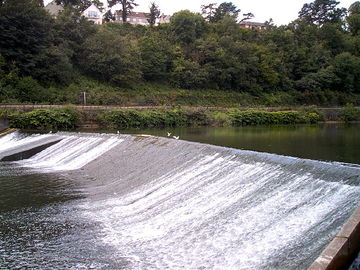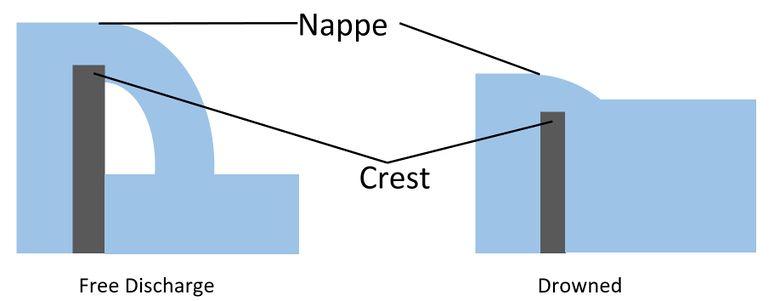Weir

A weir is a small barrier that is built across a stream or river to raise the water level slightly on the upstream side, and is essentially a small-scale dam. Weirs allow for water to pool behind them, while still allowing water to flow steadily over top of the weir itself.[2] Additionally, the term weir can be used to refer to the crest of a spillway on a large embankment dam.
Weirs can be constructed out of several different materials, depending on their age and purpose. Wood, concrete, or a mixture of rocks, gravel, and boulders can all be used to construct a weir.[2]
In a weir, the surface over which the water flows is known as the crest. The flow of water that moves overtop of this crest is known as the nappe, which is simply the water that makes it overtop the weir. This nappe does not exist with dams, as dams permit no flow of water over the structure. If this nappe falls a significant distance through the air - meaning that the weir increases the elevation of the water prior to the weir - the weir is said to have free discharge. However, if water flows partially underwater as a result of little elevation increase from the weir it is said to be submerged or drowned.[3]

Weir vs. Dam
Weirs differ from dams in one major way. First and foremost, in a weir the water from upstream runs over top of the weir itself, constantly overflowing.[2] In a dam, water flows through spillways and penstocks instead of over top of the dam, which could actually cause damage and is known as overtopping.
Benefits and Drawbacks
Weirs can be built to measure water flow rate, to alter the flow of rivers, or to prevent flooding. Additionally, small-size weirs can be used in large hydropower developments as a way to mitigate potential harm that may come about as a result of dam development. Small weirs can help improve fish numbers, stabilize water levels, and stabilize effects of river alteration.[2]
Weirs do have drawbacks, as they can increase sedimentation and pose potential migration barriers to fish. To aid in migration, fish ladders are sometimes incorporated into weirs to aid in fish passage. Sedimentation can occur as the water slows as it goes over the weir, dropping sediment as it slows.[5] As well, as water passes over the top of the weir, the motion can alter the dissolved oxygen levels. If the water is over or under-oxygenated (called hypoxia or anoxia), this can harm the local ecology.
Weirs are particularly dangerous to humans - and are thus commonly called "drowning machines". Particularly, the circulating "backwash" of water behind the weir is easy to get trapped within, and if a swimmer or boater is caught within this cycle escape and rescue is incredibly difficult. Additionally, debris that can be trapped within this cycle of water can pose harm to anyone trapped behind the weir.[6]
References
- ↑ Geograph. (December 29, 2015). Radyr Weir and Taff valley railway line [Online]. Available: http://www.geograph.org.uk/photo/76949
- ↑ 2.0 2.1 2.2 2.3 Green Bug Energy. (December 29, 2015). What is the difference between a dam, a weir, and a barrage? [Online]. Available: http://greenbugenergy.com/sp_faq/what-is-the-difference-between-a-dam-a-weir-and-a-barrage
- ↑ Civil Engineering Portal. (December 29, 2015). Weirs [Online]. Available: http://www.engineeringcivil.com/weirs.html
- ↑ Created internally by a member of the Energy Education team
- ↑ Minnesota Rural Water Association. (December 29, 2015). Sedimentation and Weirs [Online]. Available: http://www.mrwa.com/WaterWorksMnl/Chapter%2013%20Sedmentation.pdf
- ↑ Pennsylvania Fish and Boat Commission. (December 29, 2015). Low Head Dams [Online]. Available: http://fishandboat.com/damlow_info.htm

